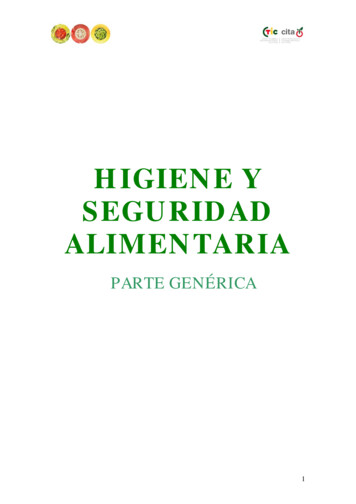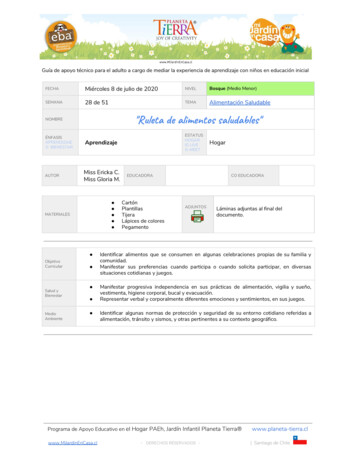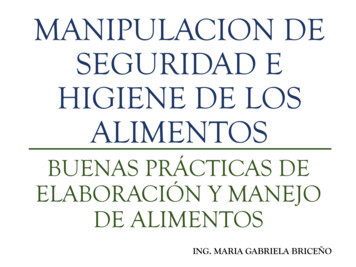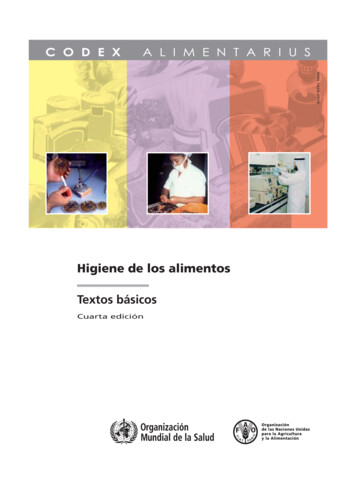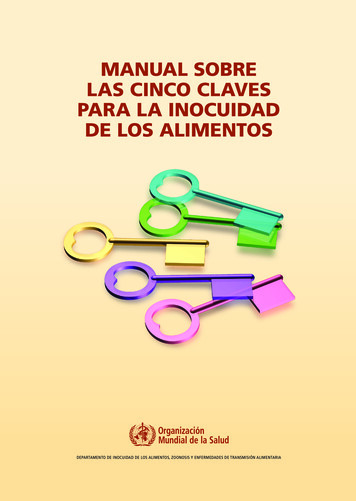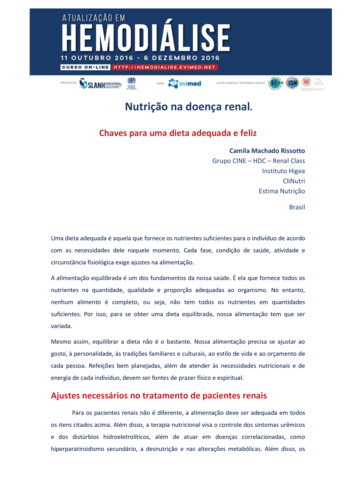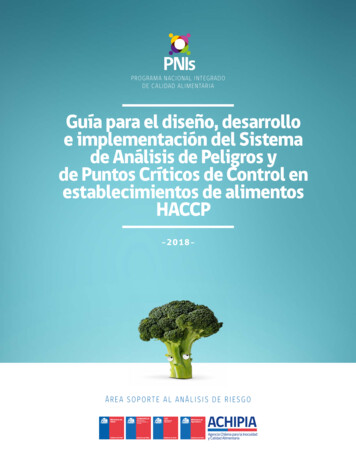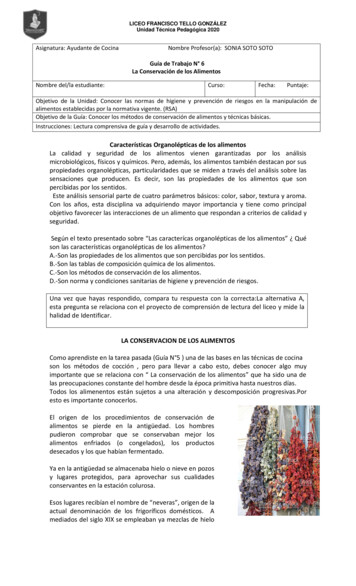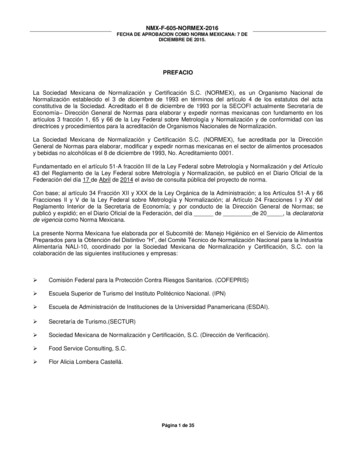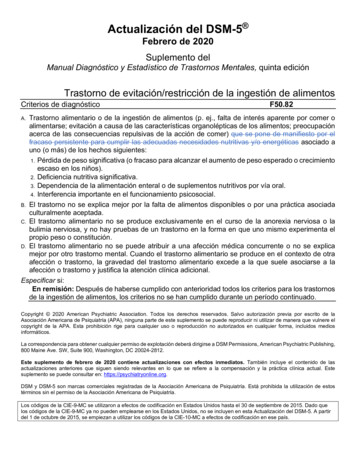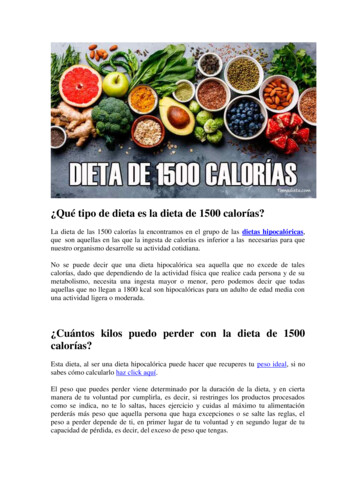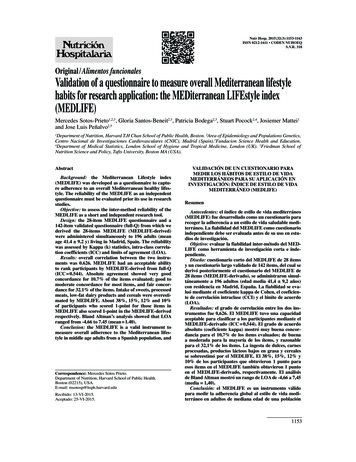
Transcription
Nutr Hosp. 2015;32(3):1153-1163ISSN 0212-1611 CODEN NUHOEQS.V.R. 318Original / Alimentos funcionalesValidation of a questionnaire to measure overall Mediterranean lifestylehabits for research application: the MEDiterranean LIFEstyle index(MEDLIFE)Mercedes Sotos-Prieto1,2,3, Gloria Santos-Beneit2,3, Patricia Bodega2,3, Stuart Pocock2,4, Josiemer Mattei1and Jose Luis Peñalvo2,51Department of Nutrition, Harvard T.H Chan School of Public Health, Boston. ²Area of Epidemiology and Populations Genetics,Centro Nacional de Investigaciones Cardiovasculares (CNIC), Madrid (Spain).3Fundacion Science Health and Education.4Department of Medical Statistics, London School of Hygiene and Tropical Medicine, London (UK). 5Friedman School ofNutrition Science and Policy, Tufts University, Boston MA (USA).AbstractBackground: the Mediterranean Lifestyle index(MEDLIFE) was developed as a questionnaire to capture adherence to an overall Mediterranean healthy lifestyle. The reliability of the MEDLIFE as an independentquestionnaire must be evaluated prior its use in researchstudies.Objective: to assess the inter-method reliability of theMEDLIFE as a short and independent research tool.Design: the 28-item MEDLIFE questionnaire and a142-item validated questionnaire (full-Q) from which wederived the 28-items MEDLIFE (MEDLIFE-derived)were administered simultaneously to 196 adults (meanage 41.4 9.2 y) living in Madrid, Spain. The reliabilitywas assessed by Kappa (k) statistics, intra-class correlation coefficients (ICC) and limits of agreement (LOA).Results: overall correlation between the two instruments was 0.626. MEDLIFE had an acceptable abilityto rank participants by MEDLIFE-derived from full-Q(ICC 0.544). Absolute agreement showed very goodconcordance for 10.7% of the items evaluated; good tomoderate concordance for most items, and fair concordance for 32.1% of the items. Intake of sweets, processedmeats, low-fat dairy products and cereals were overestimated by MEDLIFE. About 38%, 15%, 12% and 10%of participants who scored 1-point for those items inMEDLIFE also scored 1-point in the MEDLIFE-derivedrespectively. Bland Altman’s analysis showed that LOAranged from -4.66 to 7.45 (mean 1.40).Conclusion: the MEDLIFE is a valid instrument tomeasure overall adherence to the Mediterranean lifestyle in middle age adults from a Spanish population, andCorrespondence: Mercedes Sotos Prieto.Department of Nutrition, Harvard School of Public Health.Boston (02215), USA.E-mail: msotosp@hsph.harvard.eduRecibido: 13-VI-2015.Aceptado: 25-VI-2015.VALIDACIÓN DE UN CUESTIONARIO PARAMEDIR LOS HÁBITOS DE ESTILO DE VIDAMEDITERRÁNEOS PARA SU APLICACIÓN ENINVESTIGACIÓN: ÍNDICE DE ESTILO DE VIDAMEDITERRÁNEO (MEDLIFE)ResumenAntecedentes: el índice de estilo de vida mediterráneo(MEDLIFE) fue desarrollado como un cuestionario pararecoger la adherencia a un estilo de vida saludable mediterráneo. La fiabilidad del MEDLIFE como cuestionarioindependiente debe ser evaluada antes de su uso en estudios de investigación.Objetivo: evaluar la fiabilidad inter-método del MEDLIFE como herramienta de investigación corta e independiente.Diseño: cuestionario corto del MEDLIFE de 28 ítemsy un cuestionario largo validado de 142 ítems, del cual sederivó posteriormente el cuestionario del MEDLIFE de28 ítems (MEDLIFE-derivado), se administraron simultáneamente a 196 adultos (edad media 41,4 9,2 años)con residencia en Madrid, España. La fiabilidad se evaluó mediante el coeficiente kappa de Cohen, el coeficiente de correlación intraclase (CCI) y el límite de acuerdo(LOA).Resultados: el grado de correlación entre los dos instrumentos fue 0,626. El MEDLIFE tuvo una capacidadaceptable para clasificar a los participantes mediante elMEDLIFE-derivado (ICC 0,544). El grado de acuerdoabsoluto (coeficiente kappa) mostró muy buena concordancia para el 10,7% de los ítems evaluados; de buenaa moderada para la mayoría de los ítems, y razonablepara el 32,1% de los ítems. La ingesta de dulces, carnesprocesadas, productos lácteos bajos en grasa y cerealesse sobreestimó por el MEDLIFE. El 38%, 15%, 12% y10% de los participantes que obtuvieron 1 punto paraesos ítems en el MEDLIFE también obtuvieron 1 puntoen el MEDLIFE-derivado, respectivamente. El análisisde Bland Altman mostró un rango de LOA de -4,66 a 7,45(media 1,40).Conclusión: el MEDLIFE es un instrumento válidopara medir la adherencia global al estilo de vida mediterráneo en adultos de mediana edad de una población1153026 9387 Validacion de un cuestionario.indd 115310/08/15 15:16
could be used as an independent questionnaire in clinicaland epidemiological studies for such population. Its generalizability and predictive validity for clinical outcomesremains to be investigated.española, y podría ser utilizado como cuestionario independiente en estudios clínicos y epidemiológicos para talpoblación. Su generalización y validez predictiva para losparámetros clínicos debe ser investigada.(Nutr Hosp. 2015;32:1153-1163)(Nutr Hosp. :10.3305/nh.2015.32.3.9387Key words: Reliability. Mediterranean diet. Dietary index. Lifestyle. Questionnaire.Palabras clave: Fiabilidad. La dieta mediterránea. Índices dietéticos. Estilo de vida. Cuestionario.IntroductionMethodsSeveral dietary indices have emerged during the lastdecade as an integrated measure of a healthy eating pattern and an alternative method to assess diet-diseaserelations1,2. One of these healthy eating patterns is theMediterranean diet (MD), which has been consistentlyshown to protect against the development of chronic diseases3-5. In epidemiological research, a number of indices have been developed to study compliance with thetraditional MD6, such as the Mediterranean Diet Score(MDS)7,8, Mediterranean Adequacy Index (MAI)9, MedDiet Score10, MEDAS11, and relative Mediterranean Diet(rMED)12, among others.After those indices were created, the MediterraneanDiet Foundation’s International Scientific Committee updated the recommendations in 2010 to include other traditional Mediterranean lifestyle behaviors, such as restingpatterns, social structures, consumption of seasonal anddiverse foods, and other healthy culinary techniques13,14.In order to address these Mediterranean lifestyle-behaviors altogether, we recently described the development of MEDLIFE (MEDiterranean LIFEstyle)15, a newindex that incorporates those revised recommendations.MEDLIFE was developed with the aim of strengtheningthe evidence of a protective effect of the Mediterraneanlifestyle on health-related diseases and potentially support new recommendations into public health policies.Unlike prior indices, the MEDLIFE includes additionalemerging lifestyle-factors beyond diet that have been alsoassociated with cardiovascular outcomes namely sociability, sleep and rest, and conviviality16-19, and new dietarycomponents and eating behaviors (e.g. water as the mainbeverage).Nevertheless, assessing the reliability of indices is anessential step before its use in epidemiological studies.While most of currently available dietary indices havebeen developed for epidemiological research and havebeen assessed as for their construct and content validity11,20-24, only few have been further developed to independent tools or short questionnaires for utilization inclinical settings11,25 .We previously reported the construct and content validity of MEDLIFE15. The objective of this study was toassess the inter-method reliability of a 28-items MEDLIFE questionnaire as an independent tool by comparingits performance against a validated full block 142-itemsquestionnaire.Participants’ recruitment1154026 9387 Validacion de un cuestionario.indd 1154Nutr Hosp. 2015;32(3):1153-1163Participants for this study included 196 adultswho worked in public schools (teacher or staff) orwere involved in the school environment (familymembers) from 6 control schools participating in theProgram SI! Intervention, which aimed to promotehealthy lifestyle habits in preschoolers. No intervention was undertaken on these schools26. Individualswho volunteered to participate had to be older than18 years old, and were required to not be involved inany lifestyle-related intervention. Study questionnaires were administered by a trained dietitian. All participants gave written informed consent. The studywas conducted in accordance with the Declarationof Helsinki and the protocol was approved by theRegional Committee for Clinical Research Ethics(CEIC-R) of Madrid Area.Assessment of lifestyle behaviorsLifestyle assessment was completed using twoinstruments: the MEDLIFE 28-items questionnaire,and a full-length block 142-items questionnaire (full-Q) that has been previously validated and includesa food frequency questionnaire, a physical activityquestionnaire and other questions related to lifestylehabits27-29. From the full-Q we derived the 28-itemsMEDLIFE, in order to later compare whether thesame information provided by both instruments(MEDLIFE 28-items questionnaire and MEDLIFE-derived from the full-Q) by the same participantagreed.28-items MEDLIFEMEDLIFE was created based on the Mediterranean Food Guide pyramid proposed in 2010 by theMediterranean Diet Foundation13,14. In brief, a totalof 28 items were developed based on its recommendations and categorized into three blocks: (1)Mediterranean food consumption (15 items); (2)Mediterranean dietary habits (7 items); (3) Physical Activity, rest, social habits and conviviality (6Mercedes Sotos-Prieto et al.10/08/15 15:16
items). Each item was scored as 0 for not meetingthe cutoff established for the item or 1 for meeting it,so that the complete MEDLIFE ranged from 0 to 28,with a higher value indicative of greater adherenceto Mediterranean lifestyle (Table I).For this inter-method reliability study, we included the 28 items extracted from the full-Q. However,the 28-item MEDLIFE questionnaire administeredto participants had four additional questions to address the seasonality and frugality included in theMediterranean lifestyle pyramid that are not included in this analysis because this information was notassessed from the full-Q, and therefore comparisonbetween the two tools was not possible (Supplementary material)Full-length block 142-items questionnaire (full-Q)Dietary intakes and habits were assessed usinga semi-quantitative food frequency questionnaire(FFQ) previously validated in Spain30, capturinglong-term intake during the year preceding the examination, and taking into account seasonal variations and differences between weekday and weekendpatterns. The questionnaire was based on 136 fooditems, including specific questions about consumption of supplements and information on adherenceto restrictive diets. Each food included in the questionnaire specified the serving size and offered nineoptions for frequency of consumption, from “neveror almost never” to “more than six times a day”.The questionnaire also included items on physical activity based on the Spanish validated version27of the Nurses’ Health Study (NHS) and Health Professionals’ Follow-up (HPFS) physical activityquestionnaires28,29. It also included questions aboutresting and sedentary habits such as overall sittingtime (h/day), time watching television (h/day), timein front of a computer (h/day), sleeping (h/day), andtime socializing with friends (h/day), differentiatingbetween a typical weekday and a typical weekendday.Additionally, participants completed a questionnaire about socio-demographic characteristics including education level, income status, marital status,school affiliation, number of children, and numberof family members.The complete full-Q was used to extract the questions included in the 28-items of the MEDLIFE questionnaire, and to score participants on their degree ofcompliance to the Mediterranean recommendations.Assessment of other covariatesAdditionally, participants completed a questionnaire about socio-demographic characteristics including education level, income status, marital status,Validation of a questionnaire to measureoverall Mediterranean lifestyle habits forresearch application.026 9387 Validacion de un cuestionario.indd 1155school affiliation, number of children, and numberof family members.Statistical analysisAs per statistical analysis plan, the distribution ofcollected variables is studied prior to applying anystatistical tests. All variables presented a normal distribution and no transformations were made for theanalyses. Participants’ characteristics were describedusing means (standard deviations) and proportions.Pearson correlation coefficients were calculated toevaluate the relationship between MEDLIFE andMEDLIFE-derived from the full-Q to establish relative validity. Absolute agreement between theMEDLIFE and MEDLIFE-derived was calculatedby Cohen’s kappa to assess categorical agreementbetween each item of the MEDLIFE (0-1) and theone obtained by MEDLIFE derived from the full-Qand by intra class correlation (ICC) and limits ofagreement (LOA) methods. Agreement between thetwo methods was further evaluated using graphicalinformation as described by Bland and Altman31,32.With this method the arithmetic differences in theMEDLIFE and MEDLIFE-derived for each individual was plotted against the mean values of the 2methods. Polynomial contrasts were used to determine P-linear trend for continuous variables. Chisquare tests were used to determine P-linear trendfor categorical variables.Statistical analyses were conducted using STATA,version 12.0 (STATACORP, College Station, Texas,USA).ResultsTable II shows the baseline characteristics of the196 participants in the validation study across tertiles of MEDLIFE. No differences on percentageof participation between participants regarding theschool affiliation were found. Those in the highertertile were more likely to be older, non-smokers andreporting higher family income.Table III shows the absolute agreement by kappastatistics between each component of the MEDLIFE and MEDLIFE-derived from full-Q. Very goodconcordance (k 0.81-1) was observed for ‘limit saltin meals’, ‘nibbling’ and ‘nap’ (10.7% of the items).Good (k 0.61-0.80) to moderate (k 0.41-0.60)agreement was found for most of the items evaluated (21.4%) such as wine, moderate consumption ofred meat, legumes, fruit and olive oil consumption)and fair (0.21-0.40) for 32.1% of the items. Sweets,processed meats, low fat dairy products and cerealswere overestimated by MEDLIFE. From the participants who obtained 1-point for those items in theMEDLIFE, only 38%, 15%, 12% and 10 % respecti-Nutr Hosp. 2015;32(3):1153-1163115510/08/15 15:16
Table IThe Mediterranean Lifestyle index (MEDLIFE) questionnaireCriteria for1 point*ItemsBlock 1: Mediterranean food consumptionHow many serving of pastries do you consume per week? (candy (1s 1 unit or 50 g), chocolates (1 s 30 g),biscuits (1 s 4-6 units), nougat (“turrón”) (1s 40 g)) 2 s/weekHow many servings of red meat do you consume per week? (Beef, pork, lamb (1 s 100-150 g)) 2 s/weekHow many serving of processed meat do you consume per week? (Ham (1 s 1 slice or 30 g), sausage, soft spicysausage, bacon (1 s 50 g), hamburger (1 s 1 unit), liver (1 s 100-150 g), paté (1s 25 g)) 1 s/weekHow many eggs do you consume per week? (Eggs (1 egg))2-4 s/weekHow many serving of legumes do you consume per week? (Lentils, beans, peas, chickpeas (1 s 1 plate or 150 g)) 2/ weekHow many servings of white meat do you consume per week? (Poultry, rabbit (1 s 100-150 g))2 s/ weekHow many serving of fish or seafood portions do you consume per week? (White/fatty fish (1 s 100-150 g),canned fish (1 s 1 can or 50 g), seafood (1 s 200 g)) 2/ weekHow many potatoes do you consume per week? (Roasted/boiled potatoes, French fries (1 s 150-200 g)) 3 s/weekHow many low-fat dairy products do you consume per day? (Skimmed dairy milk (1s 200 ml milk, two yogurts,1 portion soft cheese))2 s/dayHow many nuts and olives do you consume per day? (Walnuts, almonds, hazelnuts (1s 1 handful or 30 g),olives (1 s 10 units))1-2 s/dayHow many times do you use herbs, spices or garnish for cooking per day? (Onion, garlic, herbs (parsley,oregano)) 1 s/dayHow many pieces of fruit do you consume per day? (All fruit and fresh fruit-based juices (1 s 150-200 g))3-6 s/dayHow many servings of vegetables do you consume per day? (All vegetables except potatoes (1 s 150-200 g)) 2 s/dayHow many tablespoons of olive oil do you consume per day (cooking or salad dressing)? (Olive oil,virgin olive oil (1s 1 Tablespoon)) 3 s/dayHow many servings of cereals do you consume per day? (White and whole-grain bread (1s 40 g),cereals (1s 1 plate rice, pasta or 40 g breakfast cereals) and derivatives)3-6 s /dayBlock 2: Mediterranean dietary habitsDo you drink more than 6 glasses of water or at least one cup of tea per day? (Water or tea (1 s 1 glass))Do you drink wine at mealtime every day? (White/red wine (1 s 1 glass of wine))Yes1-2 s/ dayDo you limit added salt in meals?YesDo you usually choose whole grain products? (bread, pasta, rice, breakfast cereals)YesDo you consume snacks 2 or less times per week? (potatoes chips, tortilla chips, popcorn (1 s 1 bag or 50 g))YesDo you usually limit nibbling between meals?YesDo you limit intake of sugar in beverages? (including sugar-sweetened beverages)YesBlock 3: Physical activity, rest, social habits and convivialityDo you engage in physical activity ( 150min/week or 30 min/day)? (jogging, walk at a fast pace, dance,aerobics, gardening)YesDo you sleep siesta/nap?YesHow many hours do you sleep a day? (During weekdays)6-8 hour/dayHow many hours do you spend watching TV per day? (During weekdays) 1hour/dayHow many hours do you spend going out with friends during the free time (e.g. weekends)?How many hours do you practice team sports per week? 2hour/weekend 2hour/week*0 points if these criteria were not met. s serving1156026 9387 Validacion de un cuestionario.indd 1156Nutr Hosp. 2015;32(3):1153-1163Mercedes Sotos-Prieto et al.10/08/15 15:16
Supplementary Table IDetailed items of the Mediterranean Lifestyle (MEDLIFE) questionnaireCriteria for1 point*ItemsBlock 1: Mediterranean food consumptionHow many serving of pastries do you consume per week? (candy (1s 1 unit or 50 g), chocolates (1 s 30 g),biscuits (1 s 4-6 units), nougat (“turrón”) (1s 40 g)) 2 s/weekHow many servings of red meat do you consume per week? (Beef, pork, lamb (1 s 100-150 g)) 2 s/weekHow many serving of processed meat do you consume per week? (Ham (1 s 1 slice or 30 g), sausage, soft spicysausage, bacon (1 s 50 g), hamburger (1 s 1 unit), liver (1 s 100-150 g), pathe (1s 25 g)) 1 s/weekHow many eggs do you consume per week? (Eggs (1 egg))2-4 s/weekHow many serving of legumes do you consume per week? (Lentils, beans, peas, chickpeas (1 s 1 plate or 150 g)) 2/ weekHow many servings of white meat do you consume per week? (Poultry, rabbit (1 s 100-150 g))2 s/ weekHow many serving of fish or seafood portions do you consume per week? (White/oily fish (1 s 100-150 g),canned fish (1 s 1 can or 50 g), seafood (1 s 200 g)) 2/ weekHow many potatoes do you consume per week? (Roast/boiled potatoes, French fries (1 s 150-200 g)) 3 s/weekHow many low fat dairy products do you consume per day? (Skimmed dairy milk (1s 200 ml milk, two yoghurts,1 portion soft cheese))2 s/dayHow many nuts and olives do you consume per day? (Walnuts, almonds, hazelnuts (1s 1 handful or 30 g),olives (1 s 10 units))1-2 s/dayHow many times do you use herbs, spices and garnish for cooking per day? (Onion, garlic, herbs (parsley,oregano)) 1 s/dayHow many pieces of fruit do you consume per day? (All fruit and fresh fruit-based juices (1 s 150-200 g))3-6 s/dayHow many serving of vegetables you consume per day? (All vegetables except potatoes (1 s 150-200 g)) 2 s/dayHow many olive oil tablespoons do you consume per day (cooking or dress salad)? (Olive oil, virgin olive oil(1s 1 Tablespoon)) 3 s/dayHow many serving of cereals you consume per day? (White and whole-grain bread (1s 40 g),cereals (1s 1 plate rice, pasta or 40 g breakfast cereals) and derivatives)3-6 s /dayBlock 2: Mediterranean dietary habitsDo you drink more than 6 glasses of water or at least one cup of tea per day? (Water or tea (1 s 1 glass))Do you drink wine during the meals every day? (White/red wine (1 s 1 glass of wine))Yes1-2 s/ dayDo you limit salt in meals?YesDo you usually choose whole grain products? (bread, pasta, rice, breakfast cereals)YesDo you consume snacks 2 or less time per week? (potatoes chips, tortilla chips, popcorn (1 s 1 bag or 50 g))YesDo you usually limit nibbling between meals?YesDo you limit sugar in beverages? (including sugar-sweetened beverages)YesDo you prefer and consume seasonal and traditional local products, fresh and minimally processed food?YesDo you prefer and consume with moderation trying to choose small portion sizes?YesBlock 3: Physical Activity, Rest, Social habits and convivialityDo you engage in physical activity ( 150min/week or 30 min/day)? (jogging, walk at a fast pace, dance,aerobics, gardening)Do you sleep siesta/nap?YesYesHow many hours do you sleep a day? (During weekdays)6-8 hour/dayHow many hours do you spend watching TV per day? (During weekdays) 1hour/dayHow many hours do you spend going out with friends during the free time (e.g. weekends)?How many hours do you practice team sports per week? 2hour/weekend 2hour/weekHow many time do you spend having lunch during weekdays?Do you usually eat in company (with family, friends, and colleagues)? 20minYes*0 points if these criteria are not met. s servingValidation of a questionnaire to measureoverall Mediterranean lifestyle habits forresearch application.026 9387 Validacion de un cuestionario.indd 1157Nutr Hosp. 2015;32(3):1153-1163115710/08/15 15:16
Table IIDemographic characteristics of study participants (n 196) by tertile(tertile 1 low; tertile 2 medium; tertile 3 high) of MEDLIFE1Overall(n 196)FemaleLow(n 71)166 (84.7)55Medium(n 70)(77.5)64(91.4)HighP-trend(n 55)47(85.5)0.1680.132School affiliationTeacher75 (38.3)21(29.6)33(47.1)21(38.2)Parent59 (30.1)22(31.0)18(25.7)19(34.5)School staff62 (31.6)28(39.4)19(27.1)15(27.3)Age41.4 (9.0)40.6(8.9)39.5(8.8)44.8(8.7)0.010BMI (Kg/m)24.1 (4.1)24.5(4.5)23.9(3.9)23.9(3.6)0.383Household income, 22,500 115 (58.7)23(32.9)27(38.6)29(53.7)0.022Education level, high*132 (67.3)54(76.1)54(77.1)45(81.8)0.541Current smoker27 (13.8)14(19.7)9(13)4(7.3)0.044Non-smoker/former168 (85.7)57(80.3)60(87.0)51(92.7)0.0443.1 (1.1)3.1(1.1)3.1(1.1)3.2(1.0)0.4833.1 (1.0)3.1(1.1)3.1(1.1)3.1(0.9)0.923135 (68.9)34(47.9)52(74.3)49(89.1) 0.001SmokingSelf-perceived job strain (range 0-5 points)Self-perceived overall stress in life(range 0-5 points)Self-perceived healthy lifestyleValues are mean and (standard deviation) or n and (percentage).The polynomial contrast and chi square test were used to determine P-linear trend for continuous and categorical variables, respectively.*Education level was first classified according to the guidelines of the Instituto Nacional de Estadística (INE; www.ine.es) and then categorizedinto three bands according to the International Standard Classification of Education (ISCED; ionalstandard- classification-of-education.aspx, 2011): low (none or primary studies; ISDED 0–2), medium (completed high school;ISCED 3 or 4) and high (high qualification or completed university degree; ISCED 5 or 6).vely achieved 1-point as well in the MEDLIFE-derived from full-Q (item 1, 3, 9, and 15).Correlation between the two instruments was 0.626.No difference by sex was observed. Consistency between both methods was assessed by ICC. A value of0.544 (95% CI, 0.3-0.7) was calculated, suggesting thatMEDLIFE has an adequate ability to rank participantsby MEDLIFE-derived. Correlations between MEDLIFE and MEDLIFE individual blocks was 0.494 forMD food frequency consumption, 0.717 for MD dietary habits, and 0.663 for physical activity, rest, socialhabits, and conviviality. The MEDLIFE overestimatedMEDLIFE-derived (15.7 3.2 vs 14.1 2.8, respectively) (Figure 1). In the classification analysis 52.1 %of the participants were classified in the same tertile byboth instruments whereas only 7.1% were classified inthe opposite tertile.Despite the extensive use of correlation analyses tovalidate dietary assessment methods, correlation coefficients provide only limited measure of the level ofagreement between two measurements31,32. Therefore,we calculated Limits of Agreement (LOA) and showeda Bland-Altman graphic (Figure 2). LOA mean was1.40 and the range was -4.66 to 7.45, indicating an acceptable concordance despite the overestimation bias.1158026 9387 Validacion de un cuestionario.indd 1158Nutr Hosp. 2015;32(3):1153-1163DiscussionValidating an instrument designed to capture lifestyle behaviors is essential before it can be applied andextended to the general population. Few studies haveverified the inter-method reliability of the indices assessing adherence to the MD11,24,25, with most studiesbeing limited to contrasting the indices against theFFQ validity, and therefore establishing construct andcontent validity only. In addition, most of the indiceshave not been developed to be used as an independenttool in clinical or epidemiological research.The present study was conducted to evaluate thevalidity of a short 28 item-questionnaire assessed bycomparing it to a full, 147-item, questionnaire that included validated FFQ, physical activity questionnaire,and other questions related to traditional Mediterranean lifestyle33. Of the 28 items evaluated, nearly 60%(16 items) had an absolute agreement from very goodto moderate (kappa 0.41-1). Only three items had apoor agreement (kappa 0.2), namely dairy products,cereals and processed meats. These results agree withthe findings from several studies assessing the validity of dietary indices that supported that some specificfoods (dairy products and meats) tend to show poorMercedes Sotos-Prieto et al.10/08/15 15:16
Table IIIAbsolute agreement between lifestyle variables measures by MEDLIFE and MEDLIFE derived from full questionnaireMEDLIFEOf whom YESin MEDLIFEderivedbCriteria for 1 pointYESa0-28NN(%)Sweets 2 s/week11644(37.9)Red meat 2 s/week8356(67.5)Processed meat 1 s/week8012(15.0)Eggs2-4 s/week136133Legumes 2/ week90White meat2 s/ weekFish/seafoodPotatoesTotal 673(68.9)0.5679979(79.8)9740(41.2)0.211 2/ week148147(99.3)487(14.6)0.194 3 s/week164107(65.2)3227(84.4)0.3002 s/day496(12.2)147140(95.2)0.099Nuts and olives1-2 s/day3716(43.2)159147(92.5)0.394Herbs, spices and garnish 1 s/day157101(64.3)3933(84.6)0.330Low fat dairy productsNOf whom NOin MEDLIFEderivedcFruit3-6 s/day8453(63.1)11295(84.8)0.489Vegetables 2 s/day132127(96.2)6417(26.6)0.274Olive oil 3 s/day12988(68.2)6751(76.1)0.407Cereals3-6 s /day828(9.8)114111(97.4)0.0816-8 s/day or 3 s/ week13969(49.6)5744(77.2)0.207Water or teasWine1-2 s/ 7.4)0.905yes / 25g/day8664(55.8)110103(93.6)0.694 2 s/week170159(93.5)2616(61.5)0.542Limit nibbling between mealsYes113106(93.8)8380(96.4)0.896Limit sugar in beverages (includingsugar-sweetened beverages)Yes14483(57.6)5244(84.6)0.319Physical activity( 150min/week or 30 8582(96.5)111102(91.9)0.876Hours’ Sleep6-8 hour/day160160(100)3619(52.8)0.646TV hours 1hour/day115113(98.3)8163(77.8)0.783 2hour/weekend174163(93.7)2214(63.6)0.541 2hour/week4738(80.9)149114(76.5)0.482Limit salt in mealsPreference of whole grain productsSnacksGo out with friendsCollective sportsNumber (N) of participants scoring 1 point in MEDLIFE (YES) or scoring 0 points in the MEDLIFE (NO). bMEDLIFE derived: MEDLIFEderived from the full FFQ. Number of participants (percentage) from those who scored 1 point (YES) in MEDLIFE and scored as well 1-pointin the MEDLIFE derived from the full-Q. cMEDLIFE derived from the full FFQ. Number of participants (percentage) from those who scored 0point (NO) in MEDLIFE and scored as well 0-point in the MEDLIFE derived from the full-Q. *p 0.05; all other kappa values are statisticallysignificant at p 0.0001 except for low-fat dairy products (p 0.034).acorrelations with the dietary indices34-38. Indeed, thisissue was detected during content validation of theMEDLIFE15, where these items showed a weaker correlation (dairy products ρ- 0.11, cereals 0.17, andValidation of a questionnaire to measureoverall Mediterranean lifestyle habits forresearch application.026 9387 Validacion de un cuestionario.indd 1159processed meats 0.18). It is likely though that the intrinsic limitations of the FFQ as a dietary assessmenttool, could explain the lack of agreement in the presentexternal validation study: The limitation to measureNutr Hosp. 2015;32(3):1153-1163115910/08/15 15:16
2520115MEDLIFE 211111111322142111111Fig. 1.—Scatter plot ofMEDLIFE by MEDLIFE derived score (numbers of plot indicate repeat values).511122525424121111110244332151015MEDLIFE derived scorediet accurately seems to matter more when classifyingfoods into a single food category, especially becausearbitrary decisions are made. These subjective choicesvary between studies for specific food groups, specifically dairy foods (low-fat dairy products vs. wholefat) and cereals (whole vs. refined). Likewise, portionsize and the type of processed meat are also difficultto assess. To help overcome this limitation, MEDLIFEcontains specific questions on low-fat dairy products(item 9) and distinguishes between refined and whole-grain cereal products (items15 and 19). Additiona-2025Mean 2SD511201
Assessment of lifestyle behaviors Lifestyle assessment was completed using two instruments: the MEDLIFE 28-items questionnaire, and a full-length block 142-items questionnaire (fu-ll-Q) that has been previously validated and includes a food frequency questionnaire, a physical activity questionnaire and other questions related to lifestyle
